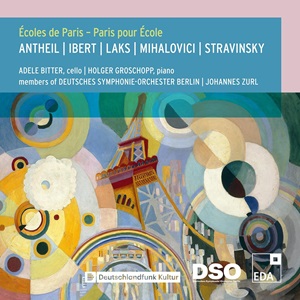
Écoles de Paris – Paris pour École
Jacques Ibert (1890-1962)
Concerto for cello and wind instruments (1925)
Marcel Mihalovici (1898-1985)
Étude for piano, wind instruments, celesta and percussion (1951)
George Antheil (1900-1959)
Concerto for chamber orchestra (1932)
Simon Laks (1901-1983)
Concerto da camera for piano, wind instruments and percussion (1963)
Adele Bitter (cello): Holger Groschopp (piano)
Members of the Deutsches Symphonie-Orchester Berlin/Johannes Zurl
rec. 2021, Haus des Rundfunks Berlin
Stravinsky’s Octet for wind instruments is available digitally via download and streaming forums
EDA 048 [66]
Unified by the acceptably all-encompassing’ School of Paris’ tag, three of these four works were all composed in the city between 1925 (Ibert) and 1963 (Laks). Whilst Stravinskian neo-classicism may have set a template, the works in this selection offer varied stylistic inheritances and the School was pluralistic enough to admit foreign adherents as, of the four representative composers in this disc, only one was a Frenchman.
It’s appropriate, then, to begin with what is probably the best-known work of the four, Ibert’s Cello Concerto, though even this hasn’t attracted many recordings over the years. André Navarra was taped in a famous performance with Martin Turnovský in Prague and that still – sonic considerations apart – offers the most satisfying recording but Adele Bitter offers a more primus inter pares alternative with Johannes Zurl. As ever, Ibert’s invention and sensibility prove winning and his concerto, lasting 13 minutes, offers three concise movements. The pictorial avian pleasures of the opening Pastorale presents an alluring Grecian landscape, the central Romance is a far more capricious entity than its movement direction might suggest, and the finale is a witty tarantella full of fascinating sonorities evoking Mediterranean zephyrs and ending in a delicious fanfare figure. Only its paltry length, itself a function of Parisian refinement and modesty, tells against the concerto in performance. How does one programme it on any kind of regular basis?
George Antheil arrived in Paris in 1923. He’d failed in London but had conquered Berlin, albeit not all of it and then controversially, and was flying high, an Icarus ready to be singed. Singed he duly was, Paris proving to be a complicated city for the composer of the Ballet mécanique and the violin sonatas, written for his mistress, the Anglo-American Olga Rudge. Eventually he was to leave for Berlin once again. The Concerto for chamber orchestra of 1932 has received some attention, but not much. The Philadelphia Chamber Orchestra has recorded it under Daniel Spalding on Naxos and so have Ensemble Modern under the redoubtable H.K. Gruber on RCA. Both offer rather faster and more incisive tempi than the one under review. The Concerto is in one movement but clearly sectional and eschews provocateur tactics in favour of a bustling brio and in the central section a threnodic element with walking bass. Adoption of neo-classicism may have done nothing for Antheil’s reputation, which has always preferred to be titillated by his hi-jinks, but this cohesive, sensibly argued work is a more creditable effort than his earlier frolics.
The Romanian-born Marcel Mihalovici, who arrived in Paris in his early ’20s, wrote his insouciantly titled Étude for piano, wind instruments, celesta and percussion after the War, which he only survived by escaping to the Liberated Zone. His wife was Monique Haas and enough examples have survived of her playing of his piano works to realise how potent and creative was their relationship. I’m not aware that she ever recorded this work, or that any broadcasts have survived, so Holger Groschopp’s promotion of it is timely as it’s not common on disc. The Andantino, the first of the two movements, unfolds eloquently and the sonority and structure are distinctive, the solo piano writing tricky but authoritative. The ensuing second movement is the longer of the two, more assertive and freer, with staccati and capricious outbursts full of archaic fire. Tonality is fascinating and the Romanian folkloric element not so hidden that it is inaudible; percussive refinement adds to the pleasure of this piece.
This label has paid considerable attention to the music of Polish-born Simon Laks whose Concerto da camera ends the programme with music of frank, lively neoclassical virtues. Laks has a way of fusing this directness with subtly romanticised elements, as in the Andantino movement, where we move from forlorn to reflective. The way he combines instruments in the finale, and the careful use of percussion, impress. There is a competing version of this on all Laks disc from CD Accord, which I’ve not heard.
If you want to hear Stravinsky’s Octet from these forces, you’ll be able to do so via download and streaming, but it’s not included on the CD.
There are full booklet notes and a fine, judiciously balanced recording This is a satisfying recital, thoughtfully and imaginatively compiled and sensitively and incisively performed.
Jonathan Woolf
Help us financially by purchasing from



















